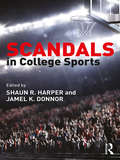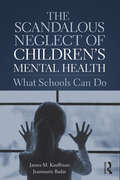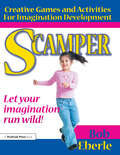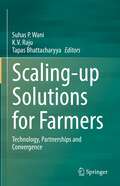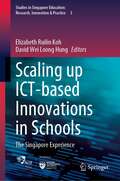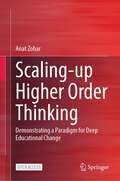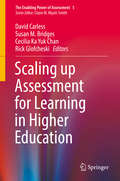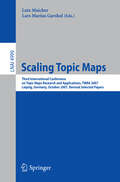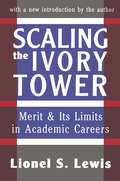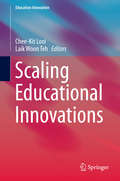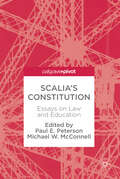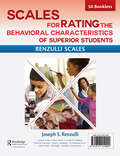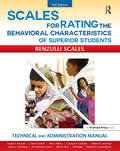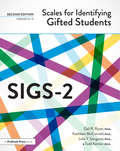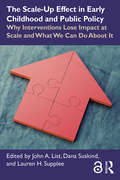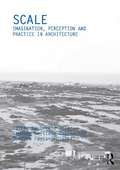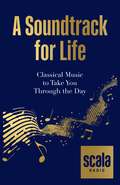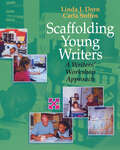- Table View
- List View
Scandals in College Sports: Legal, Ethical, And Policy Case Studies
by Shaun R. Harper Jamel K. DonnorThis timely book highlights the impact that sports have on institutions of higher education and guides college leaders and educators in informed discussions of policy and practice. Scandals in College Sports includes 21 classic and contemporary case studies and ethical dilemmas showcasing challenges that threatened the integrity and credibility of intercollegiate sports programs at a range of institutional types across the country. Cases cover NCAA policy violations and ethical dilemmas involving student-athletes, coaches, and other stakeholders, including scandals of academic misconduct, illegal recruiting practices, sexual assault, inappropriate sexual relationships, hazing, concussions, and point shaving. Each chapter author explores the details of the specific case, presents the dilemma in a broader sociocultural context, and ultimately offers an alternative ending to help guide future practice.
The Scandalous Neglect of Children’s Mental Health: What Schools Can Do
by James M. Kauffman Jeanmarie BadarThe Scandalous Neglect of Children’s Mental Health: What Schools Can Do makes the case that children with mental health needs are under-identified and under-served by schools and other agencies. After reading this brief but powerful book, you will better understand the nature of children’s mental health needs and the need for expanded services for children in schools and communities. The risks and benefits of treatment, especially early intervention, are discussed and guidelines for action by teachers, parents, and others are provided. The sad fact is that many people do not understand that most young people with mental health needs never receive any treatment of any kind and most of those who receive any treatment at all receive those services only in schools.
The Scandalous Neglect of Children’s Mental Health: What Schools Can Do
by James M. Kauffman Jeanmarie BadarThe Scandalous Neglect of Children’s Mental Health: What Schools Can Do makes the case that children with mental health needs are under-identified and under-served by schools and other agencies. After reading this brief but powerful book, you will better understand the nature of children’s mental health needs and the need for expanded services for children in schools and communities. The risks and benefits of treatment, especially early intervention, are discussed and guidelines for action by teachers, parents, and others are provided. The sad fact is that many people do not understand that most young people with mental health needs never receive any treatment of any kind and most of those who receive any treatment at all receive those services only in schools.
Scamper: Creative Games and Activities for Imagination Development (Combined ed., Grades 2-8)
by Bob EberleThis new edition of Scamper combines the activities formerly found in the original title plus Scamper On into one cohesive and user-friendly volume of the classic thinking skills games. Your students will develop their imaginations through a series of guided activities in which they imagine different events or things. Scamper is a creative thinking technique that helps students imagine the world in a completely new way. In this book, students are challenged to think creatively and develop their powers of imagination. Whether they think up new animals by combining characteristics of two very different animals, or try to imagine the perfect meal, students are motivated to create new ideas.Each activity features a complete teacher script to be read aloud to students as they participate in a Scamper exercise. Teachers are led through each exercise with step-by-step cues on when to wait, how to modify the activity for more or less participation, and how to extend the activity.Each of the imagination activities is designed to fit easily within class time and has been tested by an experienced educator. Ideal for helping students develop imagination for writing classes, the activities are also useful for any class where students must think creatively. By allowing students the freedom to explore their imaginations, they are able to better develop their creativity skills.Grades 2-8
Scamper: Creative Games and Activities for Imagination Development (Combined ed., Grades 2-8)
by Bob EberleThis new edition of Scamper combines the activities formerly found in the original title plus Scamper On into one cohesive and user-friendly volume of the classic thinking skills games. Your students will develop their imaginations through a series of guided activities in which they imagine different events or things. Scamper is a creative thinking technique that helps students imagine the world in a completely new way. In this book, students are challenged to think creatively and develop their powers of imagination. Whether they think up new animals by combining characteristics of two very different animals, or try to imagine the perfect meal, students are motivated to create new ideas.Each activity features a complete teacher script to be read aloud to students as they participate in a Scamper exercise. Teachers are led through each exercise with step-by-step cues on when to wait, how to modify the activity for more or less participation, and how to extend the activity.Each of the imagination activities is designed to fit easily within class time and has been tested by an experienced educator. Ideal for helping students develop imagination for writing classes, the activities are also useful for any class where students must think creatively. By allowing students the freedom to explore their imaginations, they are able to better develop their creativity skills.Grades 2-8
Scaling-up Solutions for Farmers: Technology, Partnerships and Convergence
by Suhas P. Wani K. V. Raju Tapas BhattacharyyaThis book provides a unique account of cross-sectoral innovations through efficient partnerships based on the hands-on experience of internationally renowned contributors specialised in the field of Science of Delivery. The challenges and lessons learned from large development initiatives based in Asia, and from the work undertaken by international research institutions, such as the FAO, are brought together in this book to benefit development agencies, policy makers, corporates, post graduate students, farmers’ organizations, and those involved in supplying agricultural inputs and/or buying agricultural produce, particularly in developing countries within Asia and Africa. Through a number of case studies the book describes how the consortium approach of capacity building for equitable and efficient benefits, collective action, and convergence, will benefit millions of small farm-holders in different regions of Asia
Scaling up ICT-based Innovations in Schools: The Singapore Experience (Studies in Singapore Education: Research, Innovation & Practice #3)
by Elizabeth Ruilin Koh David Wei Loong HungThis collected book is about the eduLab projects, an initiative with focus on Scaling Change through Apprenticising and Ecological Leadership, designed to surface and spread ground-up information and communication technology-based pedagogical innovations. It presents the goals and rationale behind eduLab, an overview of the research projects conducted by its principal investigators during its funding tenure, as well as synthesizing thoughts on the entire endeavor. This book not only marks the achievements of the eduLab programme but also serves as inspiration for future projects. It presents Singapore education in action – a continually evolving and adapting education system that delivers a system well known for its high quality as much as it is forward-looking.
Scaling-up Higher Order Thinking: Demonstrating a Paradigm for Deep Educational Change
by Anat ZoharThis open access book addresses the evasive problem of why truly effective educational innovation on a wide scale is so difficult to achieve, and what leaders may do about this. Examining the case of system-wide reform processes centering on teaching a thinking-rich curriculum, it discusses general issues pertaining to implementing deep, large-scale changes in the core of learning and instruction. The book emphasizes challenges related to professional development, assessment, achievement gaps, and the tension between knowledge and skills in 21st century curricula. It summarizes insights the author has gained from approximately 25 years of engaging with these topics both as an academic and as a practitioner who led a national change process.With a Forward by David Perkins
Scaling up Assessment for Learning in Higher Education (The Enabling Power of Assessment #5)
by David Carless Susan M. Bridges Cecilia Ka Chan Rick GlofcheskiA critical issue in higher education is the effective implementation of assessment with the core purpose of promoting productive student learning. This edited collection provides a state-of-the-art discussion of recent, cutting-edge work into assessment for learning in higher education. It introduces a new theme of scaling up, which will be welcomed by theorists, researchers, curriculum leaders and university teachers, and showcases the work of leading figures from Australia, England, continental Europe and Hong Kong. The work illuminates four key elements: (1) Enabling assessment change; (2) Assessment for learning strategies and implementation; (3) Feedback for learning; (4) Using technology to facilitate assessment for learning. Solidly research-based and carrying important implications for enhanced practice in assessment for learning at the university level, it is a must read for academic developers, researchers, university teachers, academic leaders and all those interested in assessment matters.
Scaling Topic Maps: Third International Conference on Topic Map Research and Applications, TMRA 2007 Leipzig, Germany, October 11-12, 2007 Revised Selected Papers (Lecture Notes in Computer Science #4999)
by Lutz Maicher Lars Marius GarsholThe papers in this volume were presented at TMRA 2007, the International Conference on Topic Maps Research and Applications, held October 11–12, 2007, in Leipzig, Germany. TMRA 2007 was the third conference in an annual series of international conferences dedicated to Topic Maps in science and industry. The motto of TMRA 2007 was “Scaling Topic Maps.” Taken literally the motto implies developing Topic Maps approaches that scale to large data and user volumes. This is a very real and useful research problem which is addressed by many of the contributions to the conference. But there is an even broader interpretation of the motto: wide adoption of Topic Maps in academia and industry. This is an equally important problem, and one that the TMRA conference series exists to help solve. And there is a more fanciful view on the motto. To “scale” can also mean to climb, so for the attendees the conference provided a way to “scale the mountain of Topic Maps.” In all these ways TMRA 2007 helped to scale Topic Maps.
Scaling the Ivory Tower: Merit and Its Limits in Academic Careers
by Lionel S. LewisFollowing in the tradition of Thorstein Veblen's Higher Learning in America, Lionel S. Lewis has amassed solid evidence to support his conclusions about what leads to success in Scaling the Ivory Tower. As background to his consideration of academic freedom, sexism, merit, tenure, and other such highly charged subjects, Lewis examines the attitudes of those in universities toward academic qualification. The modern rule of thumb has become publish or perish. According to Lewis, however, research and publication may not be such prime considerations after all.Two thought-provoking chapters are devoted to an examination of letters of recommendation as important factors in hiring and promoting in the academic world. Lewis also scrutinizes academic freedom cases from the archives of the American Association of University Professors. Other intriguing issues examined by Lewis are: how spouses and significant others factor into whether or not a professor gets a promotion; a typical day in the life, both academic and personal, of a professor; how the celebrity syndrome has spread to campus; discrimination against women; and bureaucracy as a contributing factor to campus unrest.In the new introduction, Lewis affirms that the most apparent changes in higher education since Scaling the Ivory Tower was initially published have actually made the campus less meritocratic, and less a place where quality academic work is recognized and rewarded. One contributing factor is the necessity to consider age, gender, ethnicity, and race in personnel decisions. Because many on campus are convinced that academic life can only be improved when the demographics of faculty reflect those in the larger society, departments are routinely expected to explain why they did not fill an opening with someone from an underrepresented group. While showing some irreverence toward academia, Scaling the Ivory Tower should also provoke sober consideration of where our colleges and universities are headed. This is a significant volume for university administrators, academics, and graduate students.
Scaling the Ivory Tower: Merit and Its Limits in Academic Careers
by Lionel S. LewisFollowing in the tradition of Thorstein Veblen's Higher Learning in America, Lionel S. Lewis has amassed solid evidence to support his conclusions about what leads to success in Scaling the Ivory Tower. As background to his consideration of academic freedom, sexism, merit, tenure, and other such highly charged subjects, Lewis examines the attitudes of those in universities toward academic qualification. The modern rule of thumb has become publish or perish. According to Lewis, however, research and publication may not be such prime considerations after all.Two thought-provoking chapters are devoted to an examination of letters of recommendation as important factors in hiring and promoting in the academic world. Lewis also scrutinizes academic freedom cases from the archives of the American Association of University Professors. Other intriguing issues examined by Lewis are: how spouses and significant others factor into whether or not a professor gets a promotion; a typical day in the life, both academic and personal, of a professor; how the celebrity syndrome has spread to campus; discrimination against women; and bureaucracy as a contributing factor to campus unrest.In the new introduction, Lewis affirms that the most apparent changes in higher education since Scaling the Ivory Tower was initially published have actually made the campus less meritocratic, and less a place where quality academic work is recognized and rewarded. One contributing factor is the necessity to consider age, gender, ethnicity, and race in personnel decisions. Because many on campus are convinced that academic life can only be improved when the demographics of faculty reflect those in the larger society, departments are routinely expected to explain why they did not fill an opening with someone from an underrepresented group. While showing some irreverence toward academia, Scaling the Ivory Tower should also provoke sober consideration of where our colleges and universities are headed. This is a significant volume for university administrators, academics, and graduate students.
Scaling Educational Innovations (Education Innovation Series)
by Chee-Kit Looi Laik Woon TehThis volume stimulates critical discussions of the different variants of implementation, translation and scaling research approaches. It presents an integrated collection of different implementation and scaling studies that analyse the different facets of co-design, learning design, curriculum development, technology development, professional development and programme implementation. It also provides critical reflections on their impact and efficacies on transforming practices, informing policy-making, and theory derivation and improvement. The chapters in this volume will provide readers a deeper understanding of scaling of educational innovations in diverse socio-cultural contexts.
Scalia’s Constitution: Essays on Law and Education
by Paul E. Peterson and Michael W. McConnellThis book explores the application of Scalia’s textualism and originalism to education law and reflects upon Scalia’s teachings and his pedagogy. Education law may seem to be an odd vehicle for considering Scalia’s constitutional approach, but thinking about schools requires attention to political fundamentals—freedom of speech, free exercise of religion, equality of opportunity, federalism, and the proper role of the expert. Legal scholars, philosophers, and political scientists provide both critiques and apologies for Scalia’s approach.
Scales for Rating the Behavioral Characteristics of Superior Students--Print Version: 50 Booklets
by Joseph RenzulliThe Scales for Rating the Behavioral Characteristics of Superior Students are commonly referred to as the Renzulli Scales orRenzulli-Hartman Scales.Now in its third edition, the Renzulli Scales are the nation's most popular tool for identifying gifted children. Supported by 40 years of research, the Renzulli Scales are used by gifted and talented programs across the country. This standardized instrument is completed by teachers and provides an effective method for identifying gifted children. The Renzulli Scales are designed to obtain teacher estimates of a student's characteristics in the following areas: Learning CharacteristicsCreativity CharacteristicsMotivation CharacteristicsLeadership CharacteristicsArtistic CharacteristicsMusical CharacteristicsDramatics CharacteristicsCommunication Characteristics (Precision)Communication Characteristics (Expressiveness)Planning CharacteristicsMathematics CharacteristicsReading CharacteristicsTechnology CharacteristicsScience CharacteristicsEach scale contains multiple items that are rated using a Likert-type scale. The first four scales (learning, creativity, motivation, and leadership) are used by most schools that use the Scales. The remaining 10 scales are focused on specific areas. They are used by schools when those areas seem appropriate for a gifted program's goals. For example, a program serving gifted math students would use the mathematics scale, a science academy would use the science scale, etc.Research shows that gifted children tend to exhibit certain observable behaviors, such as using advanced vocabulary, grasping underlying principles, and making generalizations from complex information. The Renzulli Scales asks teachers to rate children in comparison to their peers on a host of these observable behaviors. The children who score high on the scales are more likely to be gifted. Using a tool like the Scales, a school can narrow the number of students who will be fully evaluated for a gifted program.The items were chosen from a comprehensive body of research concerning the characteristics of gifted students. Based on a multiple talent approach to the identification of gifted students, the scales help identify student strengths.To explore the full collection of Renzulli Scales print and online resources, please visit: https://www.routledge.com/go/scales-for-rating-the-behavioral-characteristics-of-superior-students.
Scales for Rating the Behavioral Characteristics of Superior Students: Technical and Administration Manual
by Joseph RenzulliThis is the Technical and Administration Manual for the Scales for Rating the Behavioral Characteristics of Superior Students.The Scales for Rating the Behavioral Characteristics of Superior Students are commonly referred to as the Renzulli Scales orRenzulli-Hartman Scales.Now in its third edition, the Renzulli Scales are the nation's most popular tool for identifying gifted children. Supported by 40 years of research, the Renzulli Scales are used by gifted and talented programs across the country. This standardized instrument is completed by teachers and provides an effective method for identifying gifted children. The Scales for Rating the Behavioral Characteristics of Superior Students: Technical and Administration Manual includes technical information about how the scales were developed as well as guidelines for using the scales. The manual includes a review of the supporting research for the instrument, field test data, and construct validity support. The manual also includes in-depth information about administering the Renzulli Scales and interpreting the results.The manual features extensive appendices that include reproducible teacher training activities to help teachers understand how to use the scales and rate students, easy-to-follow instructions on how to establish local norms in a school or district, and a practical plan for identifying students for gifted and talented programs.The Renzulli Scales are designed to obtain teacher estimates of a student's characteristics in the following areas:Learning CharacteristicsCreativity CharacteristicsMotivation CharacteristicsLeadership CharacteristicsArtistic CharacteristicsMusical CharacteristicsDramatics CharacteristicsCommunication Characteristics (Precision)Communication Characteristics (Expressiveness)Planning CharacteristicsMathematics CharacteristicsReading CharacteristicsTechnology CharacteristicsScience CharacteristicsEach scale contains multiple items that are rated using a Likert-type scale. The first four scales (learning, creativity, motivation, and leadership) are used by most schools that use the Scales. The remaining 10 scales are focused on specific areas. They are used by schools when those areas seem appropriate for a gifted program's goals. For example, a program serving gifted math students would use the mathematics scale, a science academy would use the science scale, etc.Research shows that gifted children tend to exhibit certain observable behaviors, such as using advanced vocabulary, grasping underlying principles, and making generalizations from complex information. The Renzulli Scales asks teachers to rate children in comparison to their peers on a host of these observable behaviors. The children who score high on the scales are more likely to be gifted. Using a tool like the Scales, a school can narrow the number of students who will be fully evaluated for a gifted program.The items were chosen from a comprehensive body of research concerning the characteristics of gifted students. Based on a multiple talent approach to the identification of gifted students, the scales help identify student strengths.This is the Technical and Administration Manual only.
Scales for Rating the Behavioral Characteristics of Superior Students: Technical and Administration Manual
by Joseph RenzulliThis is the Technical and Administration Manual for the Scales for Rating the Behavioral Characteristics of Superior Students.The Scales for Rating the Behavioral Characteristics of Superior Students are commonly referred to as the Renzulli Scales orRenzulli-Hartman Scales.Now in its third edition, the Renzulli Scales are the nation's most popular tool for identifying gifted children. Supported by 40 years of research, the Renzulli Scales are used by gifted and talented programs across the country. This standardized instrument is completed by teachers and provides an effective method for identifying gifted children. The Scales for Rating the Behavioral Characteristics of Superior Students: Technical and Administration Manual includes technical information about how the scales were developed as well as guidelines for using the scales. The manual includes a review of the supporting research for the instrument, field test data, and construct validity support. The manual also includes in-depth information about administering the Renzulli Scales and interpreting the results.The manual features extensive appendices that include reproducible teacher training activities to help teachers understand how to use the scales and rate students, easy-to-follow instructions on how to establish local norms in a school or district, and a practical plan for identifying students for gifted and talented programs.The Renzulli Scales are designed to obtain teacher estimates of a student's characteristics in the following areas:Learning CharacteristicsCreativity CharacteristicsMotivation CharacteristicsLeadership CharacteristicsArtistic CharacteristicsMusical CharacteristicsDramatics CharacteristicsCommunication Characteristics (Precision)Communication Characteristics (Expressiveness)Planning CharacteristicsMathematics CharacteristicsReading CharacteristicsTechnology CharacteristicsScience CharacteristicsEach scale contains multiple items that are rated using a Likert-type scale. The first four scales (learning, creativity, motivation, and leadership) are used by most schools that use the Scales. The remaining 10 scales are focused on specific areas. They are used by schools when those areas seem appropriate for a gifted program's goals. For example, a program serving gifted math students would use the mathematics scale, a science academy would use the science scale, etc.Research shows that gifted children tend to exhibit certain observable behaviors, such as using advanced vocabulary, grasping underlying principles, and making generalizations from complex information. The Renzulli Scales asks teachers to rate children in comparison to their peers on a host of these observable behaviors. The children who score high on the scales are more likely to be gifted. Using a tool like the Scales, a school can narrow the number of students who will be fully evaluated for a gifted program.The items were chosen from a comprehensive body of research concerning the characteristics of gifted students. Based on a multiple talent approach to the identification of gifted students, the scales help identify student strengths.This is the Technical and Administration Manual only.
Scales for Identifying Gifted Students (SIGS-2): Examiner's Manual
by Kathleen McConnell Gail R. Ryser Laila Y. SangurasScales for Identifying Gifted Students–Second Edition (SIGS-2) offers the most comprehensive observational instrument available for identifying gifted students grades K–12. Used as part of a comprehensive process for identifying gifted children, SIGS-2 offers schools an instrument with extensive statistical and research support.
Scales for Identifying Gifted Students (SIGS-2): Examiner's Manual
by Kathleen McConnell Gail R. Ryser Laila Y. SangurasScales for Identifying Gifted Students–Second Edition (SIGS-2) offers the most comprehensive observational instrument available for identifying gifted students grades K–12. Used as part of a comprehensive process for identifying gifted children, SIGS-2 offers schools an instrument with extensive statistical and research support.
The Scale-Up Effect in Early Childhood and Public Policy: Why Interventions Lose Impact at Scale and What We Can Do About It
by John A. ListThis critical volume combines theoretical and empirical work across disciplines to explore what threatens scalability—and what enables it—in the early childhood field. Authors and editors provide specific recommendations to help professionals refine and apply the science of scaling in their programs, research, and decision making. Written by leading experts in early childhood, economics, psychology, public health, philanthropy, and more, chapters and commentaries shine light on how to effectively use experimental insights for policy purposes. The result is a comprehensive and forward-thinking guide to the challenges and possibilities of effective scaling in early childhood and beyond. Essential reading for researchers, practitioners, funders, and policy makers alike, this book raises vital questions and provides a vision for the long-term journey to scalable evidence.
The Scale-Up Effect in Early Childhood and Public Policy: Why Interventions Lose Impact at Scale and What We Can Do About It
by Dana Suskind John A. List Lauren H. SuppleeThis critical volume combines theoretical and empirical work across disciplines to explore what threatens scalability—and what enables it—in the early childhood field. Authors and editors provide specific recommendations to help professionals refine and apply the science of scaling in their programs, research, and decision making. Written by leading experts in early childhood, economics, psychology, public health, philanthropy, and more, chapters and commentaries shine light on how to effectively use experimental insights for policy purposes. The result is a comprehensive and forward-thinking guide to the challenges and possibilities of effective scaling in early childhood and beyond. Essential reading for researchers, practitioners, funders, and policy makers alike, this book raises vital questions and provides a vision for the long-term journey to scalable evidence.
Scale: Imagination, Perception and Practice in Architecture
by Gerald Adler Timothy Brittain-Catlin Gordana Fontana-GiustiScale is a word which underlies much of architectural and urban design practice, its history and theory, and its technology. Its connotations have traditionally been linked with the humanities, in the sense of relating to human societies and to human form. ‘To build in scale’ is an aspiration that is usually taken for granted by most of those involved in architectural production, as well as by members of the public; yet in a world where value systems of all kinds are being questioned, the term has come under renewed scrutiny. The older, more particular, meanings in the humanities, pertaining to classical Western culture, are where the sense of scale often resides in cultural production. Scale may be traced back, ultimately, to the discovery of musical harmonies, and in the arithmetic proportional relationship of the building to its parts. One might question the continued relevance of this understanding of scale in the global world of today. What, in other words, is culturally specific about scale? And what does scale mean in a world where an intuitive, visual understanding is often undermined or superseded by other senses, or by hyper-reality? Structured thematically in three parts, this book addresses various issues of scale. The book includes an introduction which sets the scene in terms of current architectural discourse and also contains a visual essay in each section. It is of interest to undergraduate and postgraduate students, academics and practitioners in architecture and architectural theory as well as to students in a range of other disciplines including art history and theory, geography, anthropology and landscape architecture.
Scale: Imagination, Perception and Practice in Architecture
by Gerald Adler Timothy Brittain-Catlin Gordana Fontana-GiustiScale is a word which underlies much of architectural and urban design practice, its history and theory, and its technology. Its connotations have traditionally been linked with the humanities, in the sense of relating to human societies and to human form. ‘To build in scale’ is an aspiration that is usually taken for granted by most of those involved in architectural production, as well as by members of the public; yet in a world where value systems of all kinds are being questioned, the term has come under renewed scrutiny. The older, more particular, meanings in the humanities, pertaining to classical Western culture, are where the sense of scale often resides in cultural production. Scale may be traced back, ultimately, to the discovery of musical harmonies, and in the arithmetic proportional relationship of the building to its parts. One might question the continued relevance of this understanding of scale in the global world of today. What, in other words, is culturally specific about scale? And what does scale mean in a world where an intuitive, visual understanding is often undermined or superseded by other senses, or by hyper-reality? Structured thematically in three parts, this book addresses various issues of scale. The book includes an introduction which sets the scene in terms of current architectural discourse and also contains a visual essay in each section. It is of interest to undergraduate and postgraduate students, academics and practitioners in architecture and architectural theory as well as to students in a range of other disciplines including art history and theory, geography, anthropology and landscape architecture.
Scala Radio's A Soundtrack for Life: Classical Music to Take You Through the Day
by Scala RadioBringing together much-loved masterpieces with exciting new works, this accessible and inspiring guide is a celebration of classical music. With pieces ranging from Vaughan Williams's The Lark Ascending and Beethoven's Pastoral Symphony to the scores for Avatar and Assassin's Creed, each entry puts the piece of music into context, providing fascinating insights into the inspirations behind each work and enhancing your listening experience. Organised into Occasions and Themes, the book features music to accompany you through your day, from getting up and getting dressed to running, reading, walking the dog, cooking, taking a bath, going to sleep and everything in between. You'll also find expert curations of the world's most romantic music and the greatest Christmas choral works as well as compositions that celebrate the natural world and mark births and marriages. Perfect for classical music enthusiasts as well as anyone looking for an enjoyable introduction to this genre, this is the definitive modern guide to classical music.
Scaffolding Young Writers: A Writer's Workshop Approach
by Linda Dorn Carla SoffosThe goal of teaching writing is to create independent and self-motivated writers. When students write more often, they become better at writing. They acquire habits, skills, and strategies that enable them to learn more about the craft of writing. Yet they require the guidance and support of a more knowledgeable person who understands the writing process, the changes over time in writing development, and specific techniques and procedures for teaching writing. In Scaffolding Young Writers: A Writers' Workshop Approach , Linda J. Dorn and Carla Soffos present a clear road map for implementing writers' workshop in the primary grades. Adopting an apprenticeship approach, the authors show how explicit teaching, good models, clear demonstrations, established routines, assisted teaching followed by independent practice, and self-regulated learning are all fundamental in establishing a successful writers' workshop. There is a detailed chapter on organizing for writers' workshop, including materials, components, routines, and procedures. Other chapters provide explicit guidelines for designing productive mini-lessons and student conferences. Scaffolding Young Writers also features: An overview of how children become writers; Analyses of students' samples according to informal and formal writing assessments Writing checklists, benchmark behaviors, and rubrics based on national standards Examples of teaching interactions during mini-lessons and writing conferences Illustrations of completed forms and checklists with detailed descriptions, and blank reproducible forms in the appendix for classroom use Instruction is linked with assessment throughout the book, so that all teaching interactions are grounded in what children already know and what they need to know as they develop into independent writers.
